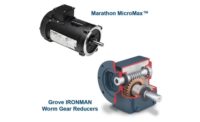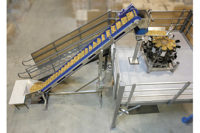As the economy continues to slowly improve, some bakers and snack manufacturers are assessing their equipment needs and deciding to invest in new machinery to help meet growing demand for their goods, new product lines, more stringent food-safety mandates and a host of other production-related issues. A new conveyor system is sure to top many food producers’ to-buy lists, and they’ll have many new models from which to choose this year.
“2014 will be a big year for conveyor-technology advancements,” says Blake Svejkovsky, manager of product handling for Heat and Conttol Hayward, Calif. “We start the year off with our new FastBack FDX horizontal motion conveyor. FDX provides all of the benefits FastBack is noted for—near-zero product damage, quiet operation, no product segregation of blends, no seasoning loss and buildup in the conveyor pan—in a very small, single drive that can handle runs of 100 ft. long.”
This drive makes up the basis for the company’s new SwitchBack 3.0 and SwitchBack 10.0 accumulation systems, which provide gentle and ultra-clean switchback accumulation capacities of 3 and 10 cu. meters, respectively, and offer an alternative to belted accumulation systems.
Svejkovsky says Heat and Control’s new Mid Revolution Gate brings Revolution Gate advantages such as gentle handling and no product pinching as it eliminates cross contamination and provides safe operation without motion sensors. It also provides accurate proportional feeding to a wider application base, and can be mounted at the end or even in the middle of a FastBack conveyor pan.
A new WeighBack loadcell measuring conveyor system, meanwhile, uses the company’s patented pan arrangement and FastBack motion to eliminate maintenance and cleaning issues of typical weigh belts, while offering accuracies three times that of vibratory systems, according to Svejkovsky.
Good vibes
Global packaging solutions specialist tna, Sydney, recently introduced gateless vibration and horizontal-motion distribution conveyors. “We’re the only company that produces a true gateless system,” says Roger Treacher, tna’s Dallas-based global sales manager. “We have no mechanical device whatsoever on the end of either of our trays—horizontal or vibratory. We have different ways of controlling the discharge relative to downstream demand that positions the tray to allow more or less product to exit the tray. We’ve got patents on both.”
The rofloHM 3 horizontal conveyor offers total reversibility due to a feature called “switcheroo,” which tilts the conveyor pan in different directions and reverses product flow as needed. It features instantaneous conveyor movement; a programmable, linear motor drive; and stainless-steel pans. Options include a bi-directional and reversible feed, custom-length pans, a proportional-discharge control, online seasoning and more. Applications include snacks and confectionery.
For snacks, nuts, confectionary products and powders, the rofloVM 3 vibratory conveyor comes with a compact, microprocessor controller, a built-in feedback sensor in the electromagnetic coil and a continuous weld construction. Its optional features include gated formats, wet-wash and dry environment designs and vibratory scarf feeders.
Treacher says gateless solutions are “huge [in terms of] allergen [advantages], maintenance, cleanability, hygiene, health, operator safety and food safety because there’s nothing in the product stream to clean. All the workings are outside of the product stream.”
Another recent addition to tna’s vibratory distribution system is the rofloVM 3 high throw, designed for fresh produce, but also for products made with sticky ingredients, such as cranberries and raisins. “Vibratory conveyors run at low frequencies and high amplitudes,” says Treacher. “There’s a bigger radius on the spring, so they can throw the product further. If you use a conventional conveyor [for such products], a very sticky coating would just build up in time.”
The rofloVM 3 high throw features an H base to ensure small drop heights and maintains a balanced weigh ratio. The system has no-wear parts and is available with two pan sizes and multiple pan lengths.
Walker Custom Sheet Metal in Grand Rapids, Mich., designed, developed and is now manufacturing its W.O.W. (Walker Original Wash down) conveyor line, including new incline and wire-mesh models. “[These] conveyors are hygienic in design, highly sanitary and totally tool-less,” says project manager Jim Monaweck. “The frame is void of any niches or catches where food particles tend to grow biofilm and/or microorganisms.”
Because every food processor has different needs, each conveyor is a new and completely custom system, but each has the same totally tool-less and ultra-sanitary features, he says. The tool-less features enable users to disassemble the conveyor in less than two minutes. The same components can be reassembled in just two minutes. The hygienically designed frame and floor levelers (when used) help reduce the time and materials needed to clean and sanitize the conveyor.
“The new FSMA (Food Safety Modernization Act) is going to change forever the way we view many processes, equipment and conveyors, requiring food manufactures to be more responsible and accountable for the equipment they employ to produce safer food products for the consumer,” Monaweck notes.
Last summer, Key Technology Inc., Walla Walla, Wash., introduced its standard Iso-Flo vibratory conveyors and hygienic design options for all custom Iso-Flo vibratory conveyors. The standard Iso-Flo comes in multiple configurations, with a screen for fines removal and without a screen for transporting product.
According to Steve Johnson, senior director of marketing, the standard Iso-Flo model handles most snack foods and some small baked goods. “The Iso-Flo features of most interest to snack food processors include the plate frame design, all-welded construction, StrongArm spring arms and oil-free electric vibrating motors,” he says, adding that the new features also make the Iso-Flo simple to maintain and easy to clean.
“Rising government guidelines for food safety are fueling the improvement in equipment hygiene in an effort to prevent bacterial contamination of product,” Johnson says. “In addition to meeting rising food-safety standards, food processors are increasingly looking for equipment that is designed for superior sanitation to improve their manufacturing
efficiencies and reduce their exposure to product liability claims.”
Better belts
Manufacturers interested in upgrading their conveyor belts rather than investing in a new conveyor system have several new options from which to choose.
Ashworth Bros. Inc., Winchester, Va., introduced the Omni-flex 3x1-in. belt in October at the International Baking Industry Exposition (IBIE). The belt, with its 3x1-in. openings, is ideal for conveying pans, trays and larger products in spiral cooling, freezing and general conveyance applications, says Kenneth King, commercial support manager at Ashworth.
“The reduction in belt weight makes this a more economical alternative for conveying products in pans, trays and other bulk containers in applications where Omni-flex belts or similar style flex belts with smaller openings traditionally have been used,” King explains. “The Omni-flex 3x1-in. belt is the suitable where belt weight has limited one’s ability to increase product loading, thus eliminating the possibility of increasing product throughput.”
Because Ashworth retained the original Omni-flex belt design, no sprocket changes or transfer modifications are required when replacing an existing Omni-flex belt with an Omni-flex 3x1-in. belt.
The larger openings also make the belt easier to clean, especially with hard-to-clean applications, thus reducing a manufacturer’s sanitation costs. “The ability to efficiently clean both conveyor belts and conveyors is one of the most important trends we have noticed in recent years,” King says. “We [also] see consumer demand for quality food products and changing government regulations as the driving force for improved conveyor and conveyor belt design.”
More food safety moves
Sara Alcalde, bakery industry team leader, Americas, at Intralox in New Orleans, says food safety is quickly becoming “a definite factor on conveying solutions. It is already impacting the way that both conveyors and belts are designed today and is definitely a factor that end users consider at the moment of selecting solutions.”
Developed for the bakery industry, Intralox’s new S550 Tight Transfer Flat Top belt is designed to be easy to clean, with exposed rods on its underside for enhanced water access, and an open channel to flush debris to the belt edge.
The belt also provides the strength and operational reliability of modular plastic belting in tight-transfer applications. “With a 0.315-in. (8 mm) pitch, the belt protects the quality of small or delicate products when conveyed over the transfers,” Alcalde explains.
Intralox also released the DirectDrive System for spiral coolers. According to Alcalde, the patented system eliminates the most common issues related to product migration, belt tensioning and sanitation. “The technology is for applications where product orientation, belt life and oil buildup are concerns, since it eliminates the overdrive by directly engaging the belt with the drum, ensuring the belt operates with zero slip,” she says.
Rich Riva, president of Wire-Mesh Products Inc., York, Pa., says tracking continues to be a priority for Wire-Mesh’s customers. “Having the belt run straight through the furnace—both at installation and during the life of the belt—is very, very important,” he says. “[Manufacturers] are busy making their products. The last thing they want to do is fight a belt that’s not tracking properly.”
Wire-Mesh, therefore, continues to improve its line of friction-drive belts, which offer manufacturers an alternative to pinroll systems. “From a tracking perspective, pinroll systems definitely have their place,” Riva says. They’re basically a direct drive, where the roll has a series of pins that interlock with the belt. We’ve found, though, that some customers are having difficulty with wider and longer pinroll systems. The belt can be mismatched on the pinroll or miss-track, even though it’s on a pinroll, and run into the edge of the oven, which then causes product quality problems.”
Riva says Wire-Mesh has converted several customers to friction-drive belts with a tracking system and a belt aligner this year. “They can be used with any system that uses a series of rollers to move the belt through the oven,” he says.
Unlike a pinroll system, which Riva says can limit manufacturers to the number of specs they can use, a friction-drive system “opens up the universe of different belt specs. They can make the belt stronger, more open for sanitation, lighter for energy savings—there are number of different things you can do. It’s a win-win for the customer.”
According to Walker Custom Sheet Metal’s Monaweck, “The future for conveyors and conveyor belting will be interesting to watch as the tired, old unsanitary conveyors and conveyor belting give way [due] to the new government mandates being written, like the FSMA. Conveyors and belts will be designed in a new culture of ‘food defense’ and ‘maintenance efficiency’ that will add value to our conveyors. Food manufactures will demand it.”
Purchasing pointers
Thinking of purchasing a new conveyor or belt? Some of the equipment manufacturers participating in this article offer some thoughts on factors to keep in mind before buying:
When selecting a belt, bakers and snack food manufacturers should keep the following factors in mind: Ease of sanitation; ease of repair; durability; product support characteristics; and product registration requirements. —Kenneth King, commercial support manager, Ashworth Bros. Inc., Winchester, Va.
Operational benefits, reliability and/or performance gains far outweigh initial capital outlays for durable production equipment. We are also seeing a strong surge for producers looking at ways to reduce sanitation labor and downtime and improve food safety. —Blake Svejkovsky, manager of product handling for Heat and Control Inc., Hayward, Calif.
The most important consideration is whether the product/technology [manufacturers] are acquiring will accomplish their goal or is really solving the problem they currently have. —Sara Alcalde, Intralox bakery industry team leader, Americas, New Orleans
Processors should scrutinize equipment features that undermine or contribute to sanitation, knowing the most effective way to reduce the risk of product contamination is through prevention. Beyond equipment hygiene, bakers and snack manufacturers should consider conveyors holistically as part of the overall production line. —Steve Johnson, senior director of marketing, Key Technology Inc., Walla Walla, Wash.
As food manufacturers consider new sanitary conveyors and other equipment, they should ask whether the equipment meets the hygienic sanitary design standards. Are the conveyors cleanable to a microbiological level? Are the conveyors accessible to inspection, maintenance, cleaning and sanitation? Does the conveyor have any niches? Are all hollow areas are hermetically sealed? Does it have hygienic design for maintenance enclosures? —Jim Monaweck, project manager, Walker Custom Sheet Metal, Grand Rapids, Mich.















